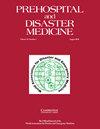配对数据分析。
IF 2.5
4区 医学
Q2 EMERGENCY MEDICINE
Prehospital and Disaster Medicine
Pub Date : 2025-04-01
Epub Date: 2025-04-11
DOI:10.1017/S1049023X25001517
引用次数: 0
摘要
统计分析中一个常见而不幸的错误是没有考虑到数据中的依赖性。在许多研究中,有一组个体参与者或实验对象,对每个个体或对象进行两次观察。这导致了数据的自然配对。这篇社论讨论了配对数据出现的常见情况,并为选择正确的分析计划提供指导,以避免统计错误。本文章由计算机程序翻译,如有差异,请以英文原文为准。
Analysis of Paired Data.
A common and unfortunate error in statistical analysis is the failure to account for dependencies in the data. In many studies, there is a set of individual participants or experimental objects where two observations are made on each individual or object. This leads to a natural pairing of data. This editorial discusses common situations where paired data arises and gives guidance on selecting the correct analysis plan to avoid statistical errors.
求助全文
通过发布文献求助,成功后即可免费获取论文全文。
去求助
来源期刊

Prehospital and Disaster Medicine
Medicine-Emergency Medicine
CiteScore
3.10
自引率
13.60%
发文量
279
期刊介绍:
Prehospital and Disaster Medicine (PDM) is an official publication of the World Association for Disaster and Emergency Medicine. Currently in its 25th volume, Prehospital and Disaster Medicine is one of the leading scientific journals focusing on prehospital and disaster health. It is the only peer-reviewed international journal in its field, published bi-monthly, providing a readable, usable worldwide source of research and analysis. PDM is currently distributed in more than 55 countries. Its readership includes physicians, professors, EMTs and paramedics, nurses, emergency managers, disaster planners, hospital administrators, sociologists, and psychologists.
 求助内容:
求助内容: 应助结果提醒方式:
应助结果提醒方式:


